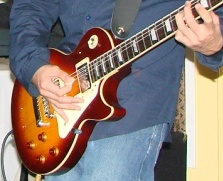We already covered the regular way of tuning the guitar on an article I posted earlier. I’m going to teach you another way that’s more fun to do the tuning process and this is using the guitar’s natural harmonics that can be found on specific nodes in the guitar fretboard. I noticed that these harmonics are more pronounced using an electric guitar. And even more so if the electric guitar is in the overdriven state, be it with the overdrive channel of the amplifier, or if you’re using the distortion mode of your multi-effects processor. However, we can also employ this tuning method on an acoustic guitar because harmonics are always there, if done correctly, regardless of the guitar type.
What’s really amusing about it is how the average listener can be easily impressed with this method of tuning. Heck, when I first heard my friend tune this way, it made such an impact on me that I wanted to learn how to do it immediately! And when I did learn how do tune this way, not only did I discover that it was so easy, I also found that using this method also has a way to determine if two strings are not in tune, if you hear a warble effect.
In my own words, this warble effect is a somewhat chirping sound that you will hear if the two strings you are tuning are not in tune with each other. However, if the said two strings are in tune, there is no warbling effect. Instead all we will hear is a harmonious unison of that particular note! This is what we want to hear when tuning the guitar with this method.
TUNING LOW “E” STRING (#6 STRING)
As we covered in the previous article on guitar tuning, we need to find a reference note for the low E string. I also mentioned the different sources for this reference note.
TUNING “A” STRING (#5 STRING)
Once we have established the low E string (#6 string), we can now proceed to the #5 string or the A string. Touch the #6 string just on top of the 5th fret. No need to push the string to the fret. Just touch the string lightly. When you pluck the string, you will hear a chime-like sound. This is the harmonic we’re looking for in the #6 string. Then, again touch the #5th string lightly just right above the 7th fret and pluck the string.
TUNING “D” STRING (#4 STRING)
Just above the 5th fret, lightly touch the #5 string and then pluck the string. While the harmonic is still sounding , lightly touch the #4 string just above the 7th fret, and then pluck it.
TUNING “G” STRING (#3 STRING)
Just above the 5th fret, lightly touch the #4 string and then pluck the string. While the harmonic is still sounding , lightly touch the #3 string just above the 7th fret, and then pluck it.
TUNING “B” STRING (#2 STRING)
We will not be using harmonics for tuning the B string because the reference note on the #3 string is taken from the 4th fret, unlike in the others which uses the 5th fret as reference point. Therefore, for the B string we will utilize the normal way of tuning which is by pressing the #3 string on the 4th fret, just as I describe in the regular way of tuning the guitar.
TUNING HIGH “E” STRING (#1 STRING)
Just above the 5th fret, lightly touch the #2 string and then pluck the string. While the harmonic is still sounding , lightly touch the #1 string just above the 7th fret, and then pluck it.
Any of the two harmonic notes played for the strings being tuned should sound the same and in tune. Otherwise, you will hear a warbling sound as mentioned earlier. This is what makes it my preferred tuning method. The sound is the indication that the strings are not in tune with each other, hence making it easier to know. This is especially helpful for those beginners who still have a bit of difficulty in distinguishing if strings are tuned or not.

